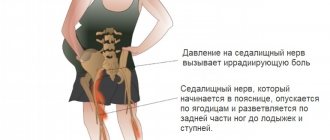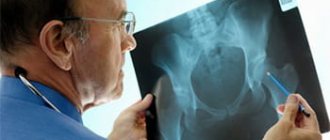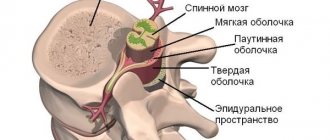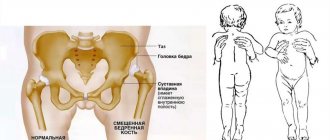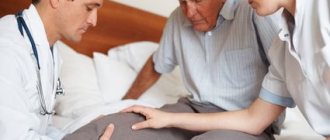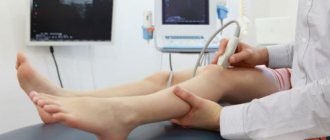Pain between the leg and groin can have different causes. Discomfort in this area occurs genetically, after physical exertion, or after injuries. Pain in the thigh indicates pathology in the internal organs and requires special attention from a medical specialist. Unpleasant sensations vary in nature, duration and intensity, but even with the slightest discomfort you should contact the clinic. At the KDS Clinic, specialists will quickly find out the cause of your ailment and prescribe effective, affordable treatment. You should not let your health reach a critical state, since then it will be much more difficult to cure the disease.
The pain between the leg and groin occurs suddenly, has a sharp, dagger-like character, stops after a few minutes and soon intensifies again. Unpleasant sensations appear in the upper thigh area and radiate to the groin. The patient's discomfort is associated with anatomical or physiological changes in the internal organs.
Why does pain occur?
The appearance of pain in the pelvic and groin areas may indicate the development of various pathologies. An experienced doctor can determine what exactly caused such symptoms after conducting a thorough examination.
Such symptoms can manifest themselves against the background of a heart attack in the hip joint, arthrosis of the hip joint, an inflammatory process in the femoral joint, or avascular necrosis.
In the human body, the hip joint (HJ) is the most powerful joint, the task of which is to provide motor activity and also maintain balance. As a result, disturbances in the functioning of this joint cause a decrease in the quality of life.
The articulation includes the acetabulum and the head of the femur, which makes movements inside this cavity. The head is covered with cartilage tissue, which ensures free gliding. There is still a significant part of the femoral neck in the joint cavity.
The most common cause of pain in the pelvic and groin area is joint injury. Not so common are factors of a non-traumatic nature, caused by various pathologies, due to which the joint, cartilage, periarticular tissues are destroyed, and the volume of synovial fluid decreases.
Diseases in different organs and systems can lead to the appearance of such signs. In some cases, pain is associated with inflammation in the area of the pubic, sacroiliac joint, gluteal muscle, and pelvic organs.
In addition, pain can develop against the background of neurological disorders - neuritis in the sciatic nerve, lumbar radiculitis, etc. Sometimes such symptoms are evidence of the development of diseases associated with articular and ligamentous tissue.
The occurrence of pain in the pelvic and groin area is associated with degenerative processes, inflammation, and injuries. Also, the reason may lie in the anatomical features of the articulation, the incorrect location of the femoral head in the acetabulum. The cause of the development of pain can be a dislocation, subluxation of the hip of a traumatic or congenital nature.
Methods of pain relief
To relieve pain in the hip joint, different methods are used:
- Local preparations. These are ointments, creams and patches that contain an active substance that relieves pain.
- Transcutaneous electrical nerve stimulation (TENS). Using a special electrode that sends impulses, the nerve endings around the affected area are affected. The procedure allows you to block pain.
- Point injections or injections of glucocorticosteroids. The specialist injects the drug into the joint using a thin needle. This relieves inflammation and relieves pain for several weeks or even months.
- Medicine pump. A special pump is placed under the patient's skin and periodically injects a drug into the bloodstream that relieves pain.
- Hot and cold procedures. To eliminate discomfort, warming or cooling heating pads and compresses, and hot salt baths are used.
Types of pain
Painful manifestations in the pelvis and groin area can vary in severity and course. The pain can be bright and sudden, and sometimes with a long period of growth.
Acute
Usually the pain is short-term, the patient is easily able to determine its location. The appearance of acute pain indicates organic damage or the formation of a disease.
At first, pain occurs in a specific place, and over time it dissipates throughout the body.
Aching
This type of pain usually appears against the background of acute pain manifestations, but covers a larger area.
Painful sensations most often increase and disappear, and after a while they appear again. It is quite difficult to determine the location of pain, which makes therapy difficult.
Chronic
This type of pain can last for more than six months. This symptom is very difficult to identify and treat. Often, to get rid of painful manifestations of a chronic nature, surgery is required.
If pain in the pelvic and groin areas of any nature systematically appears during even minor physical activity, you should immediately consult a doctor. You should not treat yourself, as the disease in its advanced form can cause serious health problems, which will require serious and long-term treatment.
Inguinal hernia
A hernia in the groin area is the most common of all types of hernias, and is 6 times more common among men than among women. With this disease, the peritoneum and internal organs of the abdominal cavity (usually the intestines) protrude under the skin through the inguinal canal. This is faced by men who are associated with hard work and have an enlarged inguinal and umbilical ring. A hernia occurs because the thinnest and weakest parts of the abdominal wall are located in the groin area.
At first there may be no pain, just a bulge. Sometimes it can be reduced, but in a lying position it may disappear. But with further development of the disease, complications are possible. Thus, pain in men in the left groin is caused by strangulation of a left-sided inguinal hernia. The same can happen on the right side if the protrusion occurs on the right.
The main pathologies manifested by pain in the hip joint
Let's look in detail at what diseases such symptoms can develop.
For arthrosis (coxarthrosis) of the hip joint
This disease is diagnosed in every third patient who goes to the doctor with complaints of lumbar pain radiating to the groin area. But, according to qualified doctors, in reality, arthrosis of the hip joint is diagnosed in approximately 30% of patients.
The pathology mostly develops in people over 40 years of age, and women are more susceptible to it. The disease can affect one or both joints at once. Usually, the disease is not detected at an early stage, since the signs are mild and, in some cases, completely absent. Over time, arthrosis progresses. This process can take more than one year, and sometimes rapid progression of the pathology is possible due to injuries, severe stress, and improper movement. In this case, the disease develops to a severe stage in just a couple of months.
With arthrosis of the hip joint, painful manifestations are localized on the thigh on the side and in front, and also radiate to the groin. You can often feel a strong ache in the buttocks with sharp pain radiating to the knee area. At the initial stage, pain appears when a person moves or loads the joint. Over time, such signs can be bothersome even when stationary and during sleep. With arthrosis of the hip joint, a person has difficulty spreading and bending his legs, and it is almost impossible to perform rotational movements of the hip.
A distinctive feature of coxarthrosis is limitations in the motor activity of the affected leg. The patient has difficulty moving, bending and straightening his knee, and moving his leg to the side. Due to lumbar pain, it is impossible to bend over.
For aseptic necrosis
The clinical picture of this pathology resembles the signs of an infarction of the femoral joint. This disease is diagnosed in only 10% of patients who consult a doctor with complaints of pain in the hip and groin area. The symptoms of aseptic necrosis are similar to arthrosis of the hip joint, which makes it difficult for doctors to correctly diagnose the disease.
With aseptic necrosis, a person is already bothered by burning pain in the joints during the first day after the onset of the disease, and the disease reaches its peak after a couple of days. A distinctive feature of this pathology is pain that bothers a person all night and subsides only at dawn. Men under 45 years of age are more susceptible to the disease. In older people, the risk of developing this disease is significantly reduced.
With trochanteritis
Another name for this disease is inflammation of the hip tendons. This is the most common disease that causes pain in the pelvic and groin areas. It is diagnosed in 30% of patients who go to the hospital with similar complaints.
Most often, the disease is diagnosed in women during the postmenopausal period, when muscle and tendon tissue weakens.
The disease can be unilateral or bilateral, development takes from 3 to 14 days. You can determine that the disease has appeared by a sharp, piercing pain localized on the outside of the femoral surface. Inflammation in the tendons leads to acute muscle pain. When moving and sleeping on the side where the damaged area is located, there is pain in the leg and groin area. In comparison with arthrosis of the hip joint, trochanteritis does not shorten the limb, and there is also no pain when abducting the leg to the side. There is no stiffness in movements.
For piriformis syndrome in the lumbar spine
This disease is diagnosed in 30-40% of patients who come to a medical facility with complaints of pain in the lumbar and groin area. The disease can develop on one or both sides, pain symptoms increase over 1-3 days. It can manifest itself regardless of the time of day with the same severity, but often the pain bothers you at night, and it is so intense that a person cannot fall asleep. It is possible that pain may intensify closer to the morning.
Against the background of this pathology, pain in the groin area is not as common as compared to arthrosis of the hip joint. It is usually localized in the lumbar and sacral region, going down the back of the lower limb into the heel. Painful sensations can appear both during the day and at night, usually while walking. Although sometimes pain can wake a person up at night. Mobility in piriformis syndrome is not impaired, but attempting to raise a straight leg can lead to severe pain in the lower back, radiating to the buttock. The reason for the development of the pathology lies in damage to the lumbar region of the spinal column.
Due to unsuccessful movements and heavy lifting, the disease develops faster. The onset of the attack is accompanied by sharp lumbar pain. Pain symptoms often radiate to the buttocks and groin. Sometimes, due to pain, stiffness appears in the space between the groin and knee. A distinctive feature of the disease is the presence of pain in the buttocks, which significantly exceeds the rest.
For polymyalgia rheumatica
This is the rarest disease that causes pain in the groin and hip joint.
This pathology is detected only in 1% of patients who consult a doctor with complaints of lumbar and groin pain. Diagnosed in women over 50 years of age after severe stress or nervous shock.
The disease is characterized by rapid development (from 3 days to 3 weeks). At first, a person is bothered by constant pain in the shoulders and back, but over time it goes down to the gluteal muscles and thigh. The patient suffers from a constant feeling of weakness.
For arthritis
This disease is often diagnosed in older people. The disease is characterized by pain in the hip area, radiating to the lower limb, groin area, often spreading to the front thigh and knee. Painful manifestations increase with movement or attempts to use the injured leg as a support. The patient has difficulty rising from a sitting position.
Severe pain appears in the morning and does not go away after light exercise. Physical activity leads to a significant increase in pain. In addition, movements become constrained, and an attempt to stand up provokes severe pain in the joints.
For bursitis
With this disease, the bursa (a vertical bursa located on top of the protrusion of the hip bone) becomes inflamed. At first, a person is bothered by pain in the gluteal muscles, radiating to the groin area. If you lie on your sore leg, the discomfort increases significantly.
For tendonitis
This pathology is accompanied by damage to the ligamentous tissue of the hip joint, which leads to a significant limitation of motor activity. It becomes difficult to move the leg to the side; due to sharp pain, when trying to make such movements, stiffness appears in the muscles. Walking and leaning on a sore leg is quite difficult.
For infectious arthritis
The cause of the development of this disease is various pathogenic microorganisms (streptococcus, staphylococcus). The disease is characterized by a rapid progression. Within a short time, swelling appears in the joint area, and hyperthermia is observed in combination with fever. Movements become painful, even touching the injured leg brings pain.
If you are concerned about mild pain that does not immediately appear, differential diagnosis is required. This will allow you to distinguish the infectious form of arthritis from tuberculosis, which is accompanied by pain, spreading to the middle thigh or knee joint. Over time, limited movement of the affected joint and swelling appear.
For tumors
Particular attention should be paid to constant aching pain. This is often evidence of the development of a benign or malignant neoplasm. Signs can vary significantly in location and intensity of pain. It is necessary to visit a doctor so that the disease is diagnosed promptly and correctly.
For enthesopathy
With this disease, pain in the groin area is bothersome, radiating to the hip joint. They increase during walking and prolonged standing.
Our doctors
Kochetov Sergey Anatolievich
Urologist, Candidate of Medical Sciences, doctor of the highest category
34 years of experience
Make an appointment
Perepechay Dmitry Leonidovich
Urologist, Candidate of Medical Sciences, doctor of the highest category
40 years of experience
Make an appointment
Mukhin Vitaly Borisovich
Urologist, Head of the Department of Urology, Candidate of Medical Sciences
34 years of experience
Make an appointment
Khromov Danil Vladimirovich
Urologist, Candidate of Medical Sciences, doctor of the highest category
35 years of experience
Make an appointment
Other causes of pain
Other diseases can also cause pain in the pelvic and groin areas. When hyperthermia and inflammation appear simultaneously in other joints, rheumatoid arthritis can be diagnosed.
Uncertain pain radiating to the lumbar region, knee, posterior thigh, or gluteal muscle is usually evidence of the development of avascular necrosis of the femoral head, leading over time to its atrophy.
Pain that slowly increases during movement and prolonged standing, accompanied by changes in gait, is often evidence of the formation of osteoarthritis.
Discomfort in the pelvic area occurs in women carrying a child. The reason is changes in hormonal levels, since the unborn baby needs calcium in large quantities.
Diseases of the reproductive system
Orchitis is inflammation of the testicles. In addition to pain in the groin, there is pain in the perineum and the affected testicle. If the disease has become chronic, then the man experiences aching pain in the groin.
Testicular torsion. Causes severe groin pain in men. It is acute, initially occurs in the scrotum, and very suddenly. The pain is so severe that it can cause nausea and vomiting.
Funiculocele is a cyst of the spermatic cord. Causes discomfort in the scrotum, which intensifies after physical activity, and a feeling of fullness. Pain is more often observed during sexual intercourse.
Varicocele is a varicose vein of the spermatic cord. The pain can be either mild or severe. Shooting and burning pain in the groin in men is most often caused by varicocele.
Other possible reasons:
- acute prostatitis,
- prostate adenoma,
- vesiculitis,
- balanoposthitis,
- prostate cancer.
How is diagnostics carried out?
Hip and groin pain can occur for numerous reasons. Initially, the patient needs examination to establish the correct diagnosis. This directly determines what therapy will be prescribed.
To determine the disease you may need:
- radiography of the hip joint;
- Dopplerography to examine vascular patency;
- CT and MRI;
- electromyography to examine tendon reflexes;
- clinical analysis of urine and blood;
- Ultrasound to determine fluid in the joint cavity;
- osteoscintigraphy to detect bone and joint abnormalities;
- densitometry to determine bone density and strength;
- biochemical, bacteriological and immunological research.
An x-ray of the hip joint is usually sufficient to identify the problem. If necessary, the doctor can prescribe a full diagnosis of the spinal column.
In what cases do you need urgent help from a specialist?
If you feel pain in your hip, monitor your condition. Perhaps the pain syndrome arose due to physical activity and after rest everything will go away. You can help yourself in such cases with the help of pharmaceutical ointments.
An examination by a specialist is urgently needed if:
- there is a visible deformity of the hip joint;
- you can't move your leg;
- the pain is so severe that it prevents you from stepping on your full foot;
- leg is swollen;
- the pain arose against the background of high fever and an infectious disease.
If you are unable to walk normally due to hip pain, see an orthopedist immediately
Treatment
Any of the listed diseases that provoke pain in the pelvic and groin area requires complex treatment. In addition, the sore leg needs rest and frequent rest.
Medicines
Usually, to relieve pain in the pelvic area, treatment with anti-inflammatory drugs is indicated - Indomethacin, Diclofenac, Ibuprofen. They can be used in tablet and ointment form.
To relieve muscle spasms, taking muscle relaxants is indicated. In case of severe clinical picture, steroids are prescribed. Diuretics help remove swelling in the tissues. Treatment with glucocorticosteroids (Prednisolone, Methylprednisolone, Dexamethasone) and chondroprotectors (Glucosamine, Chondroitin sulfate) is also indicated.
To activate blood circulation in the leg, Pentoxifylline and Tivortin are prescribed. If the pathology is accompanied by a purulent process, antibiotics are prescribed:
- macrolides (Erythromycin);
- cephalosporins (Cefoperazine, Cefazolin);
- fluoroquinolones (Moxifloxacin).
Massage
To carry out this procedure, you need to contact a specialist once every 6 months. The course of treatment for the causes of hip diseases is 10 sessions.
Physiotherapeutic procedures
Depending on the symptoms of the disease, the following treatment for the hip joint is prescribed:
- electrophoresis with Novocaine to increase the penetration ability of the drug into the damaged area;
- magnetotherapy;
- UHF;
- laser therapy, which has an anti-inflammatory, analgesic and resorption effect.
Exercise therapy
Physical therapy is prescribed after acute symptoms have been relieved and severe pain has been eliminated. The gymnastics is quite simple, it consists of abduction, adduction, flexion and extension of the leg. Initially, the exercises should be performed under medical supervision. It is optimal to perform gymnastics in a pool with warm water.
Operation
If blood or fluid is found in the joint cavity, drainage and rinsing with a special antibacterial solution is recommended.
In a more serious situation, hip replacement is indicated, which consists of replacing the destroyed joint with an artificial analogue. At the end of the surgical intervention and rehabilitation period, physical activity is resumed, which allows the person to return to their normal lifestyle.
Various diseases can provoke pain in the pelvic and groin areas. The main thing is to seek help from a doctor in a timely manner so that he can correctly diagnose and prescribe appropriate treatment.
Prevention
Doctors advise taking maximum care of yourself, especially if you are at risk. Experts recommend:
- Watch your figure and control your body weight. To do this you need to eat right.
- Avoid excessive physical activity, including carrying heavy objects and jumping from heights.
- Train, but in doses. The main goal is to strengthen the muscles of the thighs and buttocks. You can do things like cycling and swimming.
- Choose comfortable shoes. It helps reduce the risk of injury and bruises.
If pain in the pelvic area appears and does not go away, rush to the doctor. The sooner you do this, the higher your chances of staying healthy.
Bibliography:
- https://lechisustavv.ru/zabolevaniya-tazobedrennogo-sustava/12699-pochemu-proyavlyaetsya-bol-v-tazobedrennom-sustave-otdayushhaya-v-pah-kakie-bolezni-ee-vyzyvayut-pravila-terapii.html
- https://ortocure.ru/kosti-i-sustavy/boli-i-hrusty/v-tazobedrennom-sustave-otdayushhaya-v-pah.html
Diseases of the urinary system
Urolithiasis disease. This is one of the common causes of acute groin pain in men. If the resulting stone has blocked the left or right ureter, the symptom may appear in the groin on the left or right. This is associated with renal colic. In addition to pain in the groin, a man will feel acute pain along the ureter (in the abdomen), which radiates to the external genitalia and bladder. Additionally, there is a frequent urge to urinate and blood in the urine.
Other diseases of the urinary system can cause pain:
- urethritis,
- cystitis,
- hydronephrosis,
- bladder cancer.

